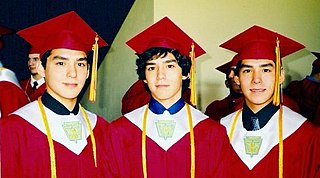This article needs additional citations for verification .(December 2009) (Learn how and when to remove this template message) |
In Irish mythology the three Findemna or Finn Eamna (variously interpreted as "fair triplets" or "three fair ones of Emain Macha") were three sons of the High King of Ireland, Eochaid Feidlech. Their names were Bres, Nár and Lothar. [1]

The mythology of pre-Christian Ireland did not entirely survive the conversion to Christianity. However, much of it was preserved in medieval Irish literature, though it was shorn of its religious meanings. This literature represents the most extensive and best preserved of all the branches of Celtic mythology. Although many of the manuscripts have not survived and much more material was probably never committed to writing, there is enough remaining to enable the identification of distinct, if overlapping, cycles: the Mythological Cycle, the Ulster Cycle, the Fenian Cycle and the Historical Cycle. There are also a number of extant mythological texts that do not fit into any of the cycles. Additionally, there are a large number of recorded folk tales that, while not strictly mythological, feature personages from one or more of these four cycles.

A multiple birth is the culmination of one multiple pregnancy, wherein the mother delivers two or more offspring. A term most applicable to placental species, multiple births occur in most kinds of mammals, with varying frequencies. Such births are often named according to the number of offspring, as in twins and triplets. In non-humans, the whole group may also be referred to as a litter, and multiple births may be more common than single births. Multiple births in humans are the exception and can be exceptionally rare in the largest mammals.

The High Kings of Ireland were sometimes historical and sometimes legendary figures who had, or who are claimed to have had, lordship over the whole of Ireland for centuries.
They conspired to overthrow their father. The day before meeting him in battle they were visited by their sister, Clothru, who tried in vain to dissuade them from this course of action. They were childless, so for fear that they might die without an heir Clothru took all three of them to bed, conceiving Lugaid Riab nDerg, son of the three Findemna. Lugaid later became High King of Ireland, so that Clothru's incest preserved the line of succession to the high kingship.
Clothru was, according to medieval Irish legend, the daughter of Eochu Feidlech, a High King of Ireland, and the sister of queen Medb of Connacht. When her triplet brothers, the findemna, were fighting with their father Eochu Feidlech for the high kingship, she was concerned that her brothers might die without heirs. She is said to have seduced the three of them, and conceived Lugaid Riab nDerg. The next day, according to legend, her brothers were indeed killed, and when Lugaid was born, he was their heir. His epithet Riab nDerg came from two red stripes around his neck and waist, dividing him into three: above the neck he resembled Nár; from the neck to the waist he resembled Bres; and from the waist down he resembled Lothar. Lugaid later also became a High King of Ireland, thus Clothru's incest preserved the line of succession. Incest features further in Clothru's story: she is said to have then slept with Lugaid herself, conceiving Crimthann Nia Náir, who later also became a High King of Ireland. She was thus Crimthann's mother, aunt and grandmother.
Lugaid Riab nDerg or Réoderg, son of the three findemna, triplet sons of Eochu Feidlech, and their sister Clothru was, according to medieval Irish legend and historical tradition, a High King of Ireland.

